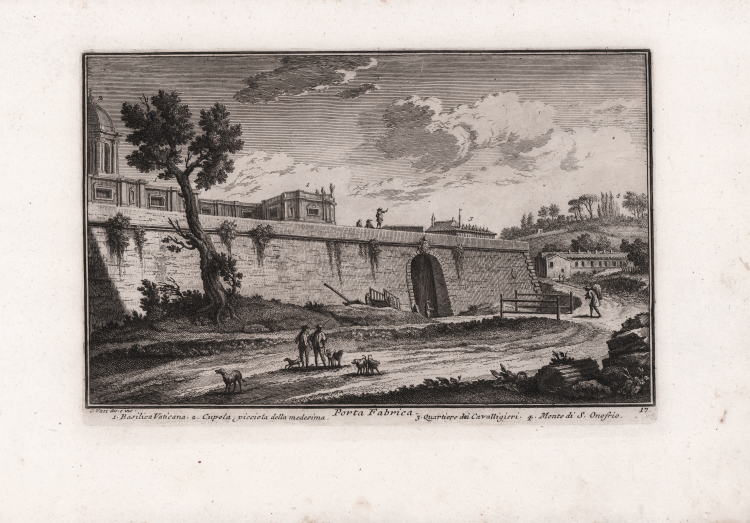



| Reference: | s27713 |
| Author | Giuseppe VASI |
| Year: | 1747 |
| Zone: | Porta Fabrica |
| Printed: | Rome |
| Measures: | 300 x 198 mm |


| Reference: | s27713 |
| Author | Giuseppe VASI |
| Year: | 1747 |
| Zone: | Porta Fabrica |
| Printed: | Rome |
| Measures: | 300 x 198 mm |
Veduta tratta dalla monumentale opera Delle magnificenze di Roma antica e moderna.
Pubblicata in 10 volumi dal 1747 al 1761, l’opera presenta 238 incisioni in rame, ciascuna incisione con testo narrativo che fornisce informazioni storiche e documentarie.
Conosciuto dai più semplicemente come il "maestro" di Giovanni Battista Piranesi, Giuseppe Vasi rivela in quest'opera monumentale la pienezza della sua creatività grafica.
I 10 libri che la compongono hanno ognuno un frontespizio con titolo e data diversi: Libro primo che contiene le porte e mura; Libro secondo, che contiene le piazze principali di Roma con obelischi, colonne, ed altri ornamenti; Libro terzo, che contiene le basiliche e chiese antiche di Roma; Libro quarto che contiene i palazzi e le vie più celebri; Libro quinto che contiene i ponti e gli edifizj sul Libro sesto che contiene la chiese parrocchiali; Libro settimo che contiene i conventi e case dei chierici regolari; Libro ottavo che contiene i monasteri e conservatorj di donne; Libro nono che contiene i collegj, spedali, e luoghi pii; decimo che contiene le ville e giardini più rimarchevoli.
Le Magnificenze forniscono un panorama completo e al tempo stesso anticonvenzionale dell'Urbe: così, insieme alle consuete, celeberrime inquadrature desunte dalla migliore tradizione vedutistica, si trova anche una Roma insolita, quella che, talvolta, non esiste più. A quest'opera, di centrale importanza nell'editoria romana di metà Settecento, l'Autore aveva lavorato per quasi un ventennio realizzando una monumentale guida dell'Urbe dove accanto alle consuete e celeberrime inquadrature tratte dalla migliore tradizione vedutistica, immortala anche scorci insoliti che sono poi scomparsi con il cambiare della città. Il testo che accompagna le vedute nel primo volume è opera di Giuseppe Bianchini, nel secondo di Orazio Orlandi e nei restanti del Vasi stesso.
A partire dall'edizione del 1786, l'opera del Vasi, fu aggiornata dal figlio Mariano, che la pubblicò col titolo Raccolta delle più belle vedute antiche, e moderne di Roma, mostrando solo il nome del padre come autore. Questa nuova edizione presentava molte tavole della prima edizione, ed alcune nuove. Anche la pubblicazione di Mariano Vasi fu stampata più volte, sempre con l’aggiunta di nuove tavole.
From the second edition of Vasi’s Delle Magnificenze di Roma Antica e Moderna, published in 1772.
This in the plate n. 17
In the description below the plate Vasi made reference to: 1) Basilica Vaticana (S. Pietro); 2) Small Dome of Cappella Clementina); 3) Cavalry Barracks near Porta Cavalleggeri; 4) Hill of Sant' Onofrio, a section of the Janiculum.
Porta Fabrica was closed in 1870 when Pope Pius IX retired to the Vatican after the Italian troops had entered Rome. The gate was walled; because the ground was raised in order to build a modern road leading to new developments along Via Aurelia, today only its upper section is barely visible.
Acquaforte, stampata su carta vergata coeva, completa dei margini, in ottimo stato di conservazione.
Giuseppe VASI (Corleone, 27 Agosto 1710 - Roma, 16 Aprile 1782)
|
Italian engraver and painter. After completing a classical education, he trained as a printmaker in Palermo, possibly at the Collegio Carolino, which was founded by the Jesuit Order in 1728 and at which the etcher Francesco Ciché ( fl before 1707; d Palermo, 1742) was a teacher. Vasi was already an accomplished engraver when, in 1736, he contributed to the illustration of La reggia in trionfo by Pietro La Placa, which described the festivities held in Palermo to mark the coronation of Charles VII of Naples (the future Charles III of Spain). That same year Vasi moved to Rome, where, as a Neapolitan subject, he was immediately afforded the protection of the ambassador, Cardinal Troiano Aquaviva d’Aragona (1694–1747). In Rome he met other artists who worked for the same patron: Sebastiano Conca, Luigi Vanvitelli and Ferdinando Fuga. It is against this background that Vasi’s work in Rome, when he was in residence at the Palazzo Farnese, should be considered: his monopoly as the engraver of the Roman records of the monarch, the plates for the festivals of the ‘Chinea’ and the triumphal arches erected in front of the Palatine gardens on the occasion of temporal sovereignty over Rome
|
Giuseppe VASI (Corleone, 27 Agosto 1710 - Roma, 16 Aprile 1782)
|
Italian engraver and painter. After completing a classical education, he trained as a printmaker in Palermo, possibly at the Collegio Carolino, which was founded by the Jesuit Order in 1728 and at which the etcher Francesco Ciché ( fl before 1707; d Palermo, 1742) was a teacher. Vasi was already an accomplished engraver when, in 1736, he contributed to the illustration of La reggia in trionfo by Pietro La Placa, which described the festivities held in Palermo to mark the coronation of Charles VII of Naples (the future Charles III of Spain). That same year Vasi moved to Rome, where, as a Neapolitan subject, he was immediately afforded the protection of the ambassador, Cardinal Troiano Aquaviva d’Aragona (1694–1747). In Rome he met other artists who worked for the same patron: Sebastiano Conca, Luigi Vanvitelli and Ferdinando Fuga. It is against this background that Vasi’s work in Rome, when he was in residence at the Palazzo Farnese, should be considered: his monopoly as the engraver of the Roman records of the monarch, the plates for the festivals of the ‘Chinea’ and the triumphal arches erected in front of the Palatine gardens on the occasion of temporal sovereignty over Rome
|